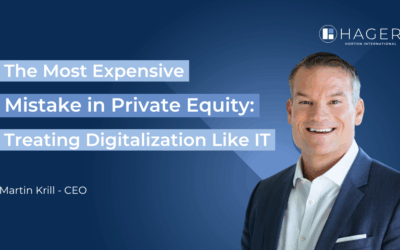Why Leadership Has Become the True Return Driver in Private Equity

The Real Moment After the Closing
The closing is complete.
The capital is deployed.
The strategy is in place.
But in the weeks that follow, the real test begins:
It’s not the model on paper that determines success — it’s the management team that turns it into reality.
Numbers and strategies create expectations.
People create results.
Private equity has always been a game of leverage — capital, time, structure.
Yet in a market shaped by fierce competition, longer holding periods, and rising pressure for operational value creation, the focus is shifting:
Leadership has become the ultimate value driver.
Put simply:
Capital accelerates — but leadership gives direction.
When Capital Meets Leadership
1. Leadership as an Underestimated Return Lever
In many transactions, the real differentiator isn’t leverage — it’s leadership.
McKinsey analyses show that funds deliberately investing in leadership achieve 2–3 percentage points higher IRR than those focused solely on financial optimization
The AlixPartners Private Equity Leadership Study 2025 supports this:
“Senior team alignment and corporate culture” rank among the most decisive factors for sustainable value creation — more critical than market conditions or capital structure.
Leadership isn’t a soft factor.
It’s the hardest lever in the portfolio — the one that determines how strategy becomes execution.
Leadership delivers where Excel ends.
2. The Human as Multiplier of Capital
A case from HAGER makes it tangible:
A PE investor acquired a fast-growing industrial company with a clear buy-and-build strategy.
After the closing, growth stagnated — until the management team was strengthened, roles redefined, and leaders developed through targeted coaching.
Within 18 months, the company evolved into a scalable platform with multiple successful acquisitions.
Das Ergebnis: Innerhalb von 18 Monaten wurde das Unternehmen zu einer skalierbaren Plattform mit mehreren erfolgreichen Akquisitionen.
The difference wasn’t in the financing.
It was in leadership — in communication, cultural alignment, and executional focus.
Capital creates speed.
Leadership ensures arrival.
In other words:
Leadership is not a companion to performance — it’s the engine behind it.
3. The DNA of High-Performing Management Teams
What defines management teams that outperform in private equity environments?
From more than 30 years of executive search and leadership consulting, HAGER has distilled five success principles:
- Clarity & Decisiveness – Bold, fast decisions amid uncertainty.
- Integration Competence – Connecting acquisitions, not just managing them.
- Cultural Intelligence – Understanding change, engaging people, maintaining direction.
- Ownership Mentality – Thinking entrepreneurially, taking responsibility, driving results.
- Learning & Adaptability – Embracing change as the new constant — and shaping it actively
These qualities form the foundation for successful buy-and-build platforms and operational excellence.
In private equity, leadership doesn’t just accompany transformation — it leads it.
4. Leadership as an Investment Strategy
The best investors treat leadership as a core component of their value-creation model.
They integrate Leadership Due Diligence — not after the closing, but before.
It’s not merely about competency analysis; it’s about asking the right strategic questions:
- Is the current management team prepared for the next growth phase?
- Do they share one vision — or merely job descriptions?
- How resilient is the leadership culture under pressure?
A structured leadership process identifies risks early, reveals gaps, and clarifies succession, coaching, and governance needs.
Funds that follow this approach report higher goal achievement, faster integrations, and more stable value creation throughout the holding period.
At HAGER Executive Consulting, we have supported private equity investors for over three decades — precisely at this intersection between capital, leadership, and transformation.
From Leadership Due Diligence and key placements to the active orchestration of buy-and-build strategies — always with one goal:
Turning management into a strategic asset.
Leadership is not an HR topic.
It’s an investment thesis.
Leadership: The Currency of Sustainable Returns
At the end of every investment cycle, two balance sheets remain:
One financial — and one human.
Capital can create value.
But only leadership ensures that value endures.
Leadership is the currency in which long-term returns are paid.
It defines speed, execution, and culture — and with it, the true return on leadership.
For forward-looking investors, the conclusion is clear:
Leadership is the most powerful — and most underutilized — value lever in private equity.
Because those who identify, empower, and align the right leaders unlock portfolio value far beyond what any spreadsheet can capture.
Or, to put it simply:
Capital creates opportunities. People create value.


